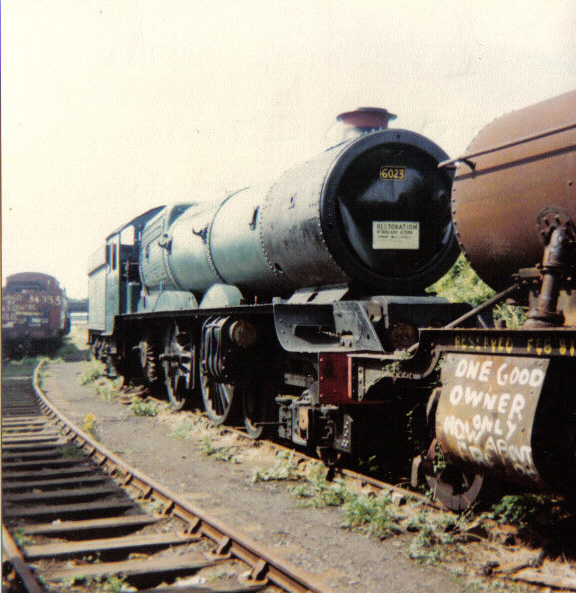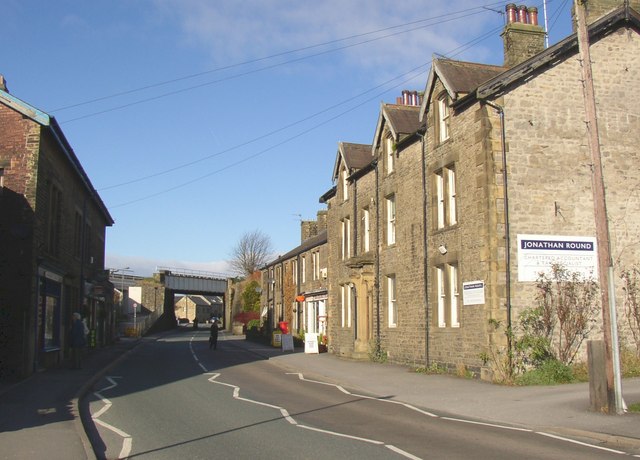|
LMS Stanier Class 8F 8151
LMS Stanier Class 8F 8151 ( British Railways No. 48151) is a preserved British steam locomotive. History 8151 was built at Crewe Works in 1942 by the LMS as one of the 8F Class. Following nationalisation in 1948, 40000 was added to the class's original numbers and so in 1949 it was renumbered to 48151. The engine originally was allocated to Grangemouth TMD and spent over thirteen years at Grangemouth before being transferred to Canklow in July 1955. Other sheds the engine was allocated to included Staveley in January 1963, Edge Hill (8A) in April 1964, and finally Northwich in March 1966. The engine remained at Northwich for its remaining working career for British Railways until January 1968, when it was withdrawn from service. 48151 was one of the last 359 steam engines operating on British mainline railways, those still in service in 1968. Preservation 48151 was sold to Woodham Brothers scrapyard on Barry Island for in September 1968, and remained there until November ... [...More Info...] [...Related Items...] OR: [Wikipedia] [Google] [Baidu] |
Aisgill
Aisgill is the southernmost of the hamlets that form the parish of Mallerstang in the English county of Cumbria. It is on the B6259 road, at the head of Mallerstang dale, just before the boundary between Cumbria and North Yorkshire. The highest waterfall on the River Eden, Hellgill Force, with a drop of about 9.75 metres (according to recent measurements) is just to the north, at . The river itself rises (at first as Red Gill beck, later becoming Hell Gill beck) below Hugh Seat in the peat bogs above here. It finally becomes the river Eden after merging with the Ais Gill beck, which flows down from Wild Boar Fell. Aisgill is at both a county and a natural geographical boundary. It is at the watershed (sometimes called "the watershed of England") from which the Eden flows north towards the Irish Sea via the Solway Firth, while the River Ure flows south towards Wensleydale, and eventually into the North Sea. Swarth Fell frames the western side of the head of Mallerstang dale, ... [...More Info...] [...Related Items...] OR: [Wikipedia] [Google] [Baidu] |
Woodham Brothers
Woodham Brothers Ltd is a trading business, based mainly around activities and premises located within Barry Docks, in Barry, Wales, Barry, South Wales. It is noted globally for its 1960s activity as a scrapyard (hence its colloquial name of Barry Scrapyard), where 297 withdrawn British Railways steam locomotives were sent, from which 213 were rescued for the developing railway preservation movement. History Established in 1892 as Woodham & Sons by Albert Woodham, the company was based at Thomson Street, Barry. The company bought old rope, dunnage wood and scrap metal from the ships, boats and marine businesses which used the newly created Barry Docks, which it then resold or scrapped. Albert retired in 1947, when his youngest son, Dai Woodham, Dai, was Demobilisation of the British Armed Forces after the Second World War, demobbed from the British Army after World War II. Dai renamed the business Woodham Brothers Ltd in 1953, creating four lines of business under four separate ... [...More Info...] [...Related Items...] OR: [Wikipedia] [Google] [Baidu] |
Manchester Victoria Railway Station
Manchester Victoria station in Manchester, England is a combined mainline railway station and Metrolink tram stop. Situated to the north of the city centre on Hunts Bank, close to Manchester Cathedral, it adjoins Manchester Arena which was constructed on part of the former station site in the 1990s. Opened in 1844 and part of the Manchester station group, Victoria is Manchester's third busiest railway station after Piccadilly and Oxford Road and the second busiest station managed by Northern after Oxford Road. The station hosts local and regional services to destinations in Northern England, such as , , Bradford, , , , Halifax, Wigan, , Blackpool (Sundays only) and Liverpool using the original Liverpool to Manchester line. Most trains calling at Victoria are operated by Northern. TransPennine Express services call at the station from Liverpool to Newcastle/Scarborough and services towards Manchester Airport (via the Ordsall Chord) from Middlesbrough/Redcar/Newcastle. Man ... [...More Info...] [...Related Items...] OR: [Wikipedia] [Google] [Baidu] |
Liverpool Lime Street Railway Station
Liverpool Lime Street is a terminus railway station and the main station serving the city centre of Liverpool. Opened in August 1836, it is the oldest still-operating grand terminus mainline station in the world. A branch of the West Coast Main Line from London Euston terminates at the station, as does the original Liverpool and Manchester Railway. Journeys from Lime Street cover a wide range of destinations across England, Scotland and Wales. Having realised that their existing Crown Street railway station was too far away from the city centre, the Liverpool and Manchester Railway commenced construction of the more central Lime Street station in October 1833. Designed by John Cunningham, Arthur Holme and John Foster Jr, it was officially opened in August 1836. Proving to be very popular with train commuters, expansion of the station had become necessary within six years of its opening. The first expansion, which was collaboratively produced by Joseph Locke, Richard Turn ... [...More Info...] [...Related Items...] OR: [Wikipedia] [Google] [Baidu] |
Shap Summit
Shap is a linear village and civil parish located among fells and isolated dales in Eden district, Cumbria, England, in the historic county of Westmorland. The parish had a population of 1,221 in 2001, increasing slightly to 1,264 at the 2011 Census. Location The village lies along the A6 road and the West Coast Main Line, and is near to the M6 motorway. It is situated from Penrith and about from Kendal. Shap is on the route of the Coast to Coast Walk. Etymology Early (12th and 13th century) forms such as ''Hep'' and ''Yheppe'' point to an Old Norse rendering ''Hjáp'' of an Old English original ''Hēap'' = "heap", (of stones), probably referring to an ancient stone circle, cairn, or to the Shap Stone Avenue just to the west of the village. History Although Shap is geographically a small village, it is legally a market town with a charter dating from the 17th century. The parish was, between 1905 and 1935, administered by an urban district council. At one time, the g ... [...More Info...] [...Related Items...] OR: [Wikipedia] [Google] [Baidu] |
Great Central Railway
The Great Central Railway in England was formed when the Manchester, Sheffield and Lincolnshire Railway changed its name in 1897, anticipating the opening in 1899 of its London Extension. On 1 January 1923, the company was grouped into the London and North Eastern Railway. History New name On assuming its new title, the Great Central Railway had a main line from Manchester London Road Station via , Sheffield Victoria, and Grimsby to . A second line left the line at Penistone and served , and Scunthorpe, before rejoining the Grimsby line at . Other lines linked Sheffield to Barnsley (via ) and Doncaster (via Rotherham) and also and Wrawby Junction. Branch lines in north Lincolnshire ran to Barton-upon-Humber and New Holland and served ironstone quarries in the Scunthorpe area. In the Manchester area, lines ran to Stalybridge and Glossop. In the 1890s, the MS&LR began constructing its Derbyshire lines, the first part of its push southwards. Leaving its east–west mai ... [...More Info...] [...Related Items...] OR: [Wikipedia] [Google] [Baidu] |
Carlisle Railway Station
Carlisle railway station, or Carlisle Citadel, is a Grade II* listed railway station serving the city of Carlisle, Cumbria, England. It is on the West Coast Main Line, south-east of and north north-west of . It is the northern terminus of the Settle and Carlisle Line, a continuation of the Midland Main Line from , and . It was formerly the southern terminus of the partially-closed Waverley Route from Edinburgh. It is so named because it is adjacent to Carlisle Citadel, a former medieval fortress. The station is owned by Network Rail. In September 1847, the first services departed the station, even though construction was not completed until the following year. It was built in a neo- Tudor style to the designs of English architect William Tite. Carlisle station was one of a number in the city; the others were Crown Street and London Road, but it became the dominant station by 1851. The other stations had their passenger services redirected to it and were closed. Between 1 ... [...More Info...] [...Related Items...] OR: [Wikipedia] [Google] [Baidu] |
Ribblehead Quarry
Ribblehead Quarry is a former limestone quarry next to railway station in the Yorkshire Dales National Park, North Yorkshire, England. It had a connection to the Settle–Carlisle line, with most of its products being sent out via the railway. History The quarry was in existence by the end of the 19th century, but the Craven Lime Company who owned it, allowed quarrying operations to lapse around 1907. Despite being located near to railway station, the quarry was not located near to a population centre, and getting workers to travel to the quarry was difficult. Originally, the stone won from the quarry was used in building the adjacent railway line, but in the early twentieth century, the stone was used in North East England for iron and steel production, along with being an additive in toothpaste and household cleaners. In 1943, the quarry was reopened to operations, producing agricultural limestone. A north connected siding was provided for the quarrying operations run by H ... [...More Info...] [...Related Items...] OR: [Wikipedia] [Google] [Baidu] |
Hellifield
Hellifield is a village and civil parish in the Craven district of North Yorkshire, England (). Historically part of the West Riding of Yorkshire, the village was once an important railway junction on the Settle-Carlisle Railway between the Midland Railway and the Lancashire and Yorkshire Railway, but Hellifield railway station is now a shadow of its former glory. It is situated on the A65, between Skipton and Settle. Hellifield had a population of 1,060 residents at the 2001 census, increasing to 1,426 at the 2011 census. History In the Domesday Book of 1086, Hellifield is mentioned as Helgeflet; meaning 'Holy Marsh or Stream', translated from Anglo-Saxon, the village also could have been dedicated to the Anglo-Saxon Goddess ' Hel'. There is also the possibility that the name derives from the Norse 'The Farm of Helgi'. The village name changed over the years; in the 12th century, Hellifield was referred to as "Nether Hellifield" and in the 17th and 18th centuries the v ... [...More Info...] [...Related Items...] OR: [Wikipedia] [Google] [Baidu] |







